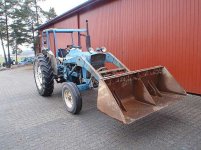Wow, Kalle! That rig is way more sophisticated than the one I used. Our cylinder was a single acting, and there was no hydraulics on the bucket. The dump was gravity tipped when you released a pin, and to get it back horizontal you had to lower the bucket and reverse the tractor until the bucket pivoted back and re-latched.
I've attached a math model of the system, as near as I can recall the details from about 50 years ago. This is one of those brute force systems, where the interest in and effect of accelration are both negligible. I created the mathematical model to demonstrate this.
There are a few points I want to note.
1) This is an open loop system. The pump flow is constant at constant rpm (ignoring insignificant items like volumetric efficiency and leakage). When the valve is in center position the pump flow is dumped back to the sump and the cylinder is blocked.
2) When the cylinder is blocked the pressure is a function of weight and cylinder diameter. There is no motion (no go) because there is no flow out of the cylinder.
3) The final velocity when raising the bucket is determined strictly by the pump flow rate SO LONG AS THE CYLINDER PRESSURE EXCEEDS THE PRESSURE CREATED BY THE LOAD. If this is not the case, there is no upward movement and there is no flow. (See Peter, I know pressure matters - it's just not the only thing that matters!)
4) Cylinder and load acceleration when raising it is determined by the relief valve setting. Once the cylinder velocity and flow equals max pump flow the pressure drops. Until then the pressure equals relief setting.
5) The time to accelrate the load is inconsequential to the operator and negligible to the system designer. This is not a servo system or a motion control system - lifting the load is all that counts. In point of fact I'm not sure the relief valve on that old tractor could respond in 90 miliseconds, but hey - it's a theoretical analysis!
Of course, if the load increases during lifting the cylinder will decelerate. How much is a function of the bulk modulus of the hydraulic fluid and the effective "spring rate" of the cylinders and hoses. I'm sure some bright young PhD candidate could figure it out if anybody cared. However, for a system like this nobody cares! (The load increase during lifting isn't common, but I have visions of an encounter with a very large flying cow as one possibility.)
6) When lowering the bucket the system changes from constant flow to constant pressure. Now the downward velocity is determined by feathering the control valve until the speed of descent matches expectation.
7) The load will accelerate at constant gravity, with the velocity increasing until the pressure drop through the valve equals the pressure caused by the load. That pressure drop increases as the square of the flow. The flow that causes the equilibrium of pressures dictates cylinder speed.
OK - I'm going to quit now. I'll never change Peter's mind, and I don't have more time to devote to this. I think I've accomplished my objectives:
a) Demonstrating to the youngin's that not all hydraulic systems are about motion control and not all systems require precise operation.
b) Demonstrating that you can adjust your mathematical model of the system to suit the physical and commercial constraints of the system. Exercise of good engineering judgement and experience means doing an analysis that verifies you meet the functional requirements of the customer and the cost constraints of the supplier. There is no benefit in doing a sophisticated analysis that doesn't help one of these parties.
c) Annoying Peter a little. I must confess to a rather juvenile annoyance of my own after the last thread on this subject was blocked. This was mostly caused by the implication that I don't understand the fundamentals of either hydraulics or Newtonian physics. The annoyance was further aggravated by the implication that there is only one way to look at any hydraulic system and that any analysis that varies from the one true methodology is defective.
Thanks for all of your patience while I indulged myself. I hope at least a few of you benefited and got a couple of chuckles out of this.
And Peter, don't take it too seriously. I KNOW you are an expert in your field and I respect that!





